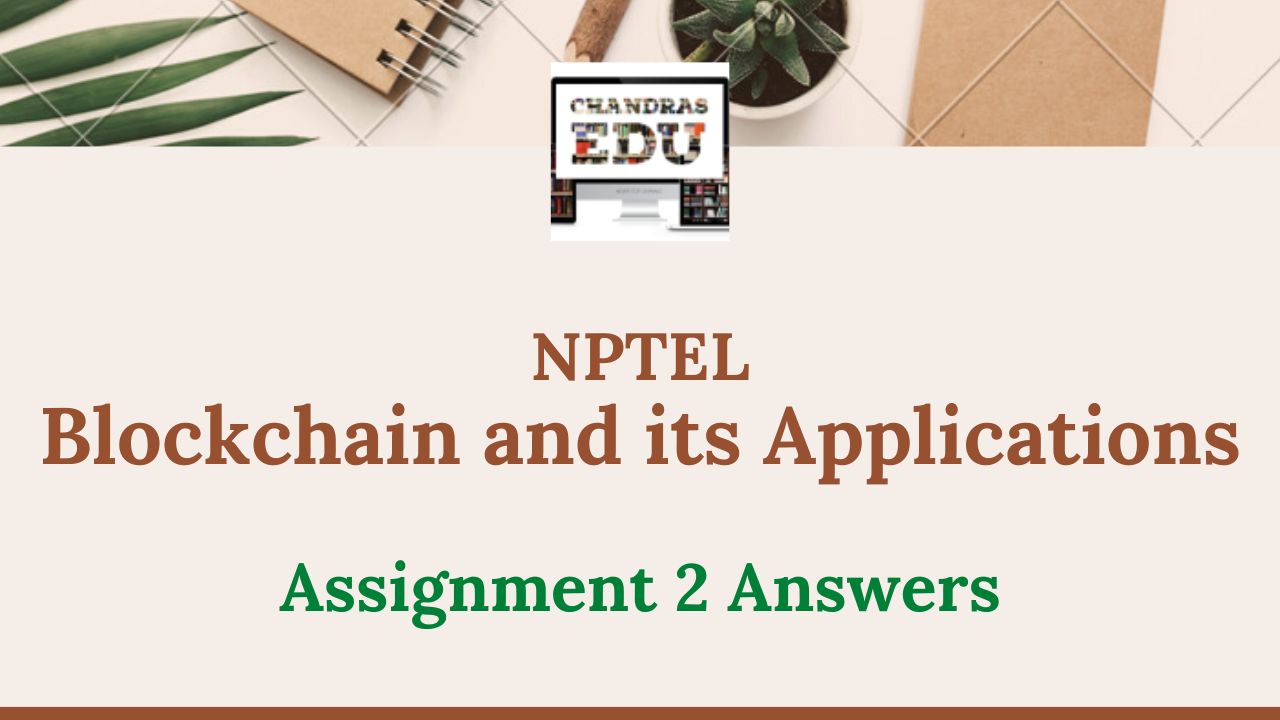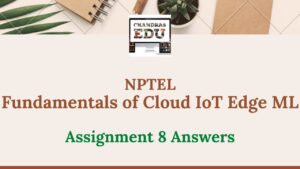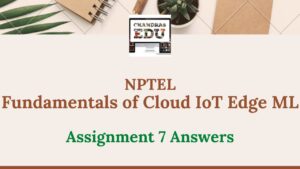Are you looking for NPTEL Blockchain and its Applications Assignment 2 Answers? Then you are in the right place. The answers for NPTEL Blockchain and its Applications Week 2 Assignment 2 follows:
Blockchain and its Applications Assignment 2 Answers
Blockchain and its Applications Assignment 2 Question 1
Let Bob wants to send a long message to Alice. Alice should be able to confirm that it was indeed sent by Bob, and Bob later cannot deny that he had sent the message. They also want that nobody else should be able to see its content. Alice and Bob plan to use public key Cryptography and cryptographic hashing techniques. Let the key pairs of Alice and Bob are (Pub A,Pri A) and (Pub B, Pri B) respectively. Let E, D and H be encryption, decryption and hash functions, respectively. Let M denote Message and H(M) its digest. Which of the following describes the correct order of steps to be used by Alice to send the digital signed message
i. At Bob: M’ = E(M, KpubA)
ii. At Alice: M = E(M’, KpriA)
iii. Bob sends the message M’ to Alice
iv The signature along with the message is sent to Alice (M,M’)
v. Bob: M’ = E(M, KpriB)
vi. Signing the message with his private key: S = E(H(M), KpriB)
vii. M = E(K’, KpubB)
a. i,iii,ii,v,iv,vii,vi
b. i,ii,iii,iv,v,vi,vii
c. v,vii,ii,i,iii,iv,vi
d. vii,vi,v,iv,iii,ii,i
Blockchain and its Applications Assignment 2 Question 1 Answer
The correct order of steps to be used by Alice to send the digital signed message is: a. i,iii,ii,v,iv,vii,vi.
- At Bob’s end, the message M is encrypted with Alice’s public key (KpubA) to form M’. This is step i: M’ = E(M, KpubA).
- At Alice’s end, the encrypted message M’ is decrypted with her private key (KpriA) to get the original message M. This is step ii: M = E(M’, KpriA).
- Bob sends the encrypted message M’ to Alice. This is step iii.
- Bob signs the message with his private key (KpriB) to generate a digital signature S. This is step vi: S = E(H(M), KpriB).
- Bob sends the digital signature S and the encrypted message M’ to Alice. This is step iv: (M,M’).
- At Alice’s end, the digital signature S is decrypted with Bob’s public key (KpubB) to get the digest of the original message M. This is step vii: M = E(K’, KpubB).
- Finally, Alice can compare the decrypted digest with the hash of the original message M to confirm that the message was indeed sent by Bob and has not been tampered with.
Note: The order of steps v and vi is interchangeable.
Blockchain and its Applications Assignment 2 Question 2
Digitally signing transactions by sender in Blockchain does not ensure to solve repudiation/verifiability problems. Is the above statement True or False?
a. True
b. False
Blockchain and its Applications Assignment 2 Question 2 Answer
False. The statement is false. Digitally signing transactions by the sender in Blockchain does indeed help to solve repudiation and verifiability problems.
In Blockchain, transactions are verified by the network nodes before being added to the blockchain. Digital signatures are used to ensure the authenticity of the transactions, so that no one can deny having sent a particular transaction. When a sender signs a transaction, they use their private key to generate a digital signature. This digital signature is then verified by the network nodes using the sender’s public key. If the digital signature is valid, the transaction is deemed to be authentic and is added to the blockchain.
In this way, digital signatures provide a way for the sender to prove that they did indeed send a particular transaction, and for the network to verify the authenticity of the transaction, thus solving the problem of repudiation.
Blockchain and its Applications Assignment 2 Question 3
Which of the following is used to point a block in block chain:
a) Hash Pointer
b) User ID
c) Transaction ID
d) Timestamp
Blockchain and its Applications Assignment 2 Question 3 Answer
The correct answer is: a) Hash Pointer.
A hash pointer is a data structure that contains the hash of a previous block in the blockchain. It is used to point to a specific block in the blockchain, making it possible to trace the history of transactions and prevent tampering with the data. A hash pointer is included in each block of the blockchain, so that each block is linked to the previous block, forming a chain of blocks.
Question 4
Suppose you have 6 data points — 1 to 6. The post-order traversal of the Merkle Tree is given by (here 6 means hash of 6, 43 means the combined hash of 4 and 3, and so on):
a) {12345656, 1234, 5656, 12, 34, 56, 56, 1, 2, 3, 4, 5, 6}
b) {1, 12, 2, 3, 4, 34, 1234, 5, 6, 56, 123456}
c) {1, 2, 12, 3, 4, 34, 1234, 5, 6, 56, 78, 5678, 12345678}
d) {1, 2, 12, 3, 4, 34, 1234, 5, 6, 56, 56, 5656, 12345656}
Question 4 Answer
The answer is d) {1,2,12,3,4,34,1234,5,6,56,56,5656,12345656}
- The post-order traversal of a Merkle Tree starts from the leaves and moves upwards.
- The leaves of the tree contain the individual data points. In this case, the leaves are 1 to 6.
- The non-leaf nodes represent the hash of the combined hashes of their children.
- In this example, the first two hashes 12 and 34 are combined to form the hash 1234, which is then combined with the next two hashes 56 and 56 to form the hash 5656.
- Finally, the hashes 1234 and 5656 are combined to form the final hash 12345656.
- The final hash is the root of the tree and represents the combined hash of all the data points.
- The post-order traversal of the tree follows the bottom-up approach and visits all the leaves and then the non-leaf nodes in a left-to-right order.
Question 5
Which of the following is true for using a digital signature in blockchain?
a. To check the validity of the source of a transactions
b. None of the given options
c. It will ensures that no one can deny of their own transaction
d. It supports user authentication
Question 5 Answer
The true statements for using a digital signature in blockchain are:
a. To check the validity of the source of a transactions
c. It will ensures that no one can deny of their own transaction
Question 6
Which are main Consensus Algorithms?
a. Proof of Work
b. Proof of Wager
c. Proof of Stake
d. Proof of Mining
Question 6 Answer
The main consensus algorithms are:
a. Proof of Work (PoW) c. Proof of Stake (PoS)
Proof of Work is a consensus algorithm used in some blockchain networks, such as Bitcoin, to achieve distributed consensus and prevent malicious behavior. In PoW, nodes compete to solve a computational puzzle and the first node to solve it is allowed to create a new block and add it to the chain.
Proof of Stake is a consensus algorithm used in some blockchain networks, such as Ethereum, to achieve distributed consensus and prevent malicious behavior. In PoS, nodes hold a stake in the network and are selected randomly to create new blocks and validate transactions based on the amount of their stake.
“Proof of Wager” and “Proof of Mining” are not commonly used consensus algorithms in blockchain systems.
Question 7
Why is consensus hard in asynchronous system?
I. No notion of global time
II. faults in network
III. nodes may crash/faulty nodes
a. II, III
b. I, II
c. I, III
d. I, II, II
Question 7 Answer
The correct option is: d. I, II, III
Question 8
Liveliness property ensures the output should be produced within a finite time limit?
a. False
b. True
Question 8 Answer
a. False
Liveness property ensures that the system should make progress in a finite amount of time, but it does not guarantee that the output will be produced within a finite time limit. Liveness refers to the ability of the system to make progress, which means that it should eventually produce an output. However, it does not specify a specific time limit for the output to be produced. This property is distinct from safety properties, which ensure that the system satisfies certain constraints, such as consistency and integrity, even in the presence of faults.
Question 9
Paxos consensus support(s) which of the below properties
a. Liveliness
b. Safety
c. Both
d. None of the above
Question 9 Answer
The correct answer is: b. Safety.
Question 10
Which is/are true for Raft consensus?
a. Crash Fault Tolerant
b. Byzantine Fault Tolerant
c. Both
d. None of the above
Question 10 Answer
The correct answer is: a. Crash Fault Tolerant
Raft consensus is a distributed consensus algorithm that is designed to be crash fault tolerant. This means that the system can continue to operate even if one or more of its nodes crashes or fails. The nodes in a Raft-based system communicate with each other to agree on the state of the system and coordinate their actions.
Raft is not Byzantine Fault Tolerant, which means that it cannot handle nodes that are intentionally malicious or sending incorrect messages.
Disclaimer: Chandras EDU does not guarantee the correctness of the answers. These answers are based on the data provided by the NPTEL video lectures, are just for reference, and request students to complete the assignments independently.
If you have any suggestions, comment below or contact us at admin@chandrashaker.com
If you found this article interesting and helpful, don’t forget to share it with your friends.




Pingback: Blockchain and its Applications Assignment 7 Answers 2023 - Chandras EDU
Pingback: Blockchain and its Applications Assignment 8 Answers 2023 - Chandras EDU
Your honesty and vulnerability in sharing your personal experiences is truly admirable It takes courage to open up and I applaud you for it
Your words have the power to change lives and I am grateful for the positive impact you have had on mine Thank you
Excellent article! It’s well-organized, informative, and written in a way that’s easy to follow. I found it very helpful.
What an excellent post! It’s packed with information and written in a way that’s easy to understand. I found it very helpful.
Thank you for the amazing blog post!
Fantastic post! It’s clear, concise, and full of practical information. I found it very helpful and will be recommending it to others.
I love how this blog promotes self-love and confidence It’s important to appreciate ourselves and your blog reminds me of that
Thank you for sharing this detailed article. It’s full of useful information and practical advice. I learned a lot and will be bookmarking this for future reference.
Great job on this article! It’s packed with valuable information and written in a way that’s easy to follow. I’ll definitely be returning to read more from your blog.
I have bookmarked your blog and refer back to it whenever I need a dose of positivity and inspiration Your words have a way of brightening up my day
We just wanted to take a moment to acknowledge all the hard work and effort you’ve been putting in lately. Keep up the amazing job, you’re doing great!
This blog post is packed with great content!
Your writing style is so engaging and makes even the most mundane topics interesting to read Keep up the fantastic work
As a fellow blogger, I can appreciate the time and effort that goes into creating well-crafted posts You are doing an amazing job
Wow, this blogger is seriously impressive!
This is such an important reminder and one that I needed to hear today Thank you for always providing timely and relevant content
Your words have a way of resonating deeply with your readers Thank you for always being encouraging and uplifting
This post truly brightened my day! I appreciate how you delve into the topic with such positivity and clarity. It’s refreshing to see content that not only informs but also uplifts the reader. Your writing style is engaging and always leaves me feeling inspired. Keep up the fantastic work!
Your blog post was really enjoyable to read, and I appreciate the effort you put into creating such great content. Keep up the great work!
Love this appreciation for great content